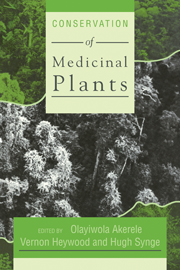Book contents
- Frontmatter
- Contents
- Contributors
- Preface
- Acknowledgements
- The Chiang Mai Declaration
- Introduction
- The Issue of Medicinal Plants
- 3 Global Importance of Medicinal Plants
- 4 Traditional Knowledge of Medicinal Plants – the Search for New Jungle Medicines
- 5 The Reason for Ethnobotanical Conservation
- Science, Industry and Medicinal Plants
- Techniques to Conserve Medicinal Plants
- Policies to Conserve Medicinal Plants
- Experiences from Programmes to Conserve Medicinal Plants
4 - Traditional Knowledge of Medicinal Plants – the Search for New Jungle Medicines
Published online by Cambridge University Press: 07 September 2010
- Frontmatter
- Contents
- Contributors
- Preface
- Acknowledgements
- The Chiang Mai Declaration
- Introduction
- The Issue of Medicinal Plants
- 3 Global Importance of Medicinal Plants
- 4 Traditional Knowledge of Medicinal Plants – the Search for New Jungle Medicines
- 5 The Reason for Ethnobotanical Conservation
- Science, Industry and Medicinal Plants
- Techniques to Conserve Medicinal Plants
- Policies to Conserve Medicinal Plants
- Experiences from Programmes to Conserve Medicinal Plants
Summary
“Through most of man's history, botany and medicine were, for all practical purposes, synonymous fields of knowledge, and the shaman, or witch-doctor – usually an accomplished botanist – represents probably the oldest professional man in the evolution of human culture.”
R.E. Schultes, 1972Conservation
In 1980, Harvard magazine asked several of the University's most prominent faculty members what they considered to be the single most serious problem facing mankind. Dr E. O. Wilson, noted entomologist and sociobiologist, wrote:
“What event likely to occur in the 1980s will our descendants most regret, even those living a thousand years from now? My opinion is not conventional, although I wish it were. The worst thing that can happen – will happen – is not energy depletion, economic collapse, limited nuclear war, or conquest by a totalitarian government. As terrible as these catastrophes would be for us, they can be repaired within a few generations. The one process ongoing in the 1980s that will take millions of years to correct is the loss of genetic and species diversity by the destruction of natural habitats. This is the folly our descendants are least likely to forgive us.”
There exists widespread agreement among biologists that the rate of species extinction is increasing at an alarming rate. Although many temperate life forms like the California condor (Gymnogyps californicus) and the black-footed ferret (Mustela nigripes) are on the verge of extinction and may disappear during the next decade, the majority of the world's threatened species inhabit the tropical forests.
- Type
- Chapter
- Information
- Conservation of Medicinal Plants , pp. 53 - 64Publisher: Cambridge University PressPrint publication year: 1991
- 5
- Cited by



